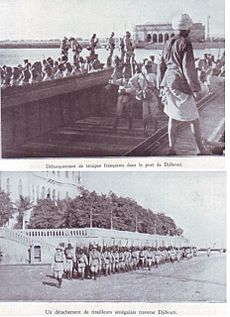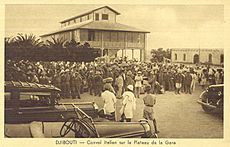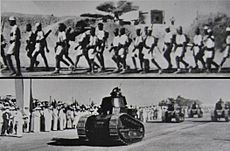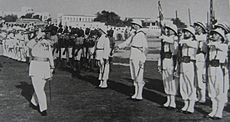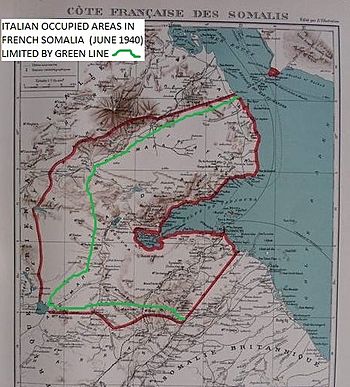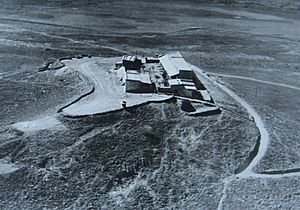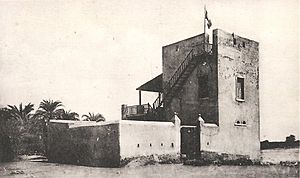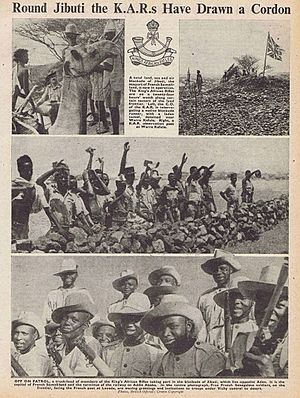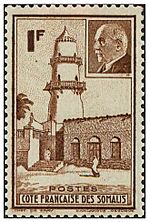French Somaliland in World War II facts for kids
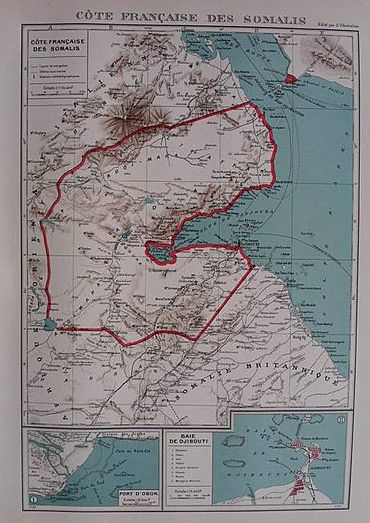
French Somaliland, with its capital city Djibouti, was a French territory in Africa. During World War II, it saw only small fights, mostly in June and July 1940. After France fell to Germany in June 1940, the colony was unsure what to do. A new governor, loyal to the Vichy government (which worked with Germany), took charge on July 25. French Somaliland was the last French area in Africa to stay loyal to Vichy. It finally joined the Free French forces (who fought against Germany) on December 26, 1942.
Pierre Nouailhetas was the governor for most of this time. After British planes bombed Djibouti, he treated people very harshly. He was later removed from his job. From September 1940, the Allies (like Britain) blocked ships from reaching the colony. Many people fled to nearby British Somaliland. After the territory was freed, new governors took over. The area slowly started to recover from the difficult years of 1940–1942, even before the war ended in 1945.
Contents
Why French Somaliland Was Important
In the mid-1930s, tensions grew between Italy and Ethiopia in Africa. At the same time, Germany was rearming in Europe. France wanted Italy's support against Germany. So, in 1935, France offered Italy a small piece of land in northern Somaliland. However, this deal was never fully completed before the war started.
In 1935, Italy invaded Ethiopia. This made France pay more attention to defending French Somaliland. In 1938, Italian troops moved into French territory. France saw this as a threat. The French colonial minister, Georges Mandel, and the commander in Djibouti, Paul Legentilhomme, greatly strengthened the colony's defenses. They sent 15,000 soldiers and built strong concrete forts.
In October 1938, Italy demanded more from France. They wanted a "free port" in Djibouti and control of the Djibouti–Addis Ababa railway. France refused these demands. They believed Italy actually wanted to take over the whole colony. On November 30, the Italian foreign minister openly demanded that French Somaliland be given to Italy.
On December 18, 1938, people in Djibouti held a large protest. They waved French flags and shouted pro-French slogans. Meanwhile, Italy built small military posts inside French Somaliland's western border. They claimed this land had always been part of Ethiopia.
In January 1940, Italy's commander in East Africa, Prince Amedeo, Duke of Aosta, planned a surprise invasion of French Somaliland. This plan involved many soldiers and local tribesmen. The plan was discovered.
Before the war, French intelligence officers helped the Ethiopian resistance against Italy. They gave them money, weapons, and advice. Even though British Somaliland was next door, and both were surrounded by Italian territory, Britain and France did not plan their defense together until June 1939. In January 1940, they met again in Djibouti. They agreed that if Italy declared war, the French commander, General Legentilhomme, would lead all Allied forces in both Somalilands.
War and Truce
Early Fights (June 10–25, 1940)
Italy declared war on France and Great Britain on June 10, 1940. The next day, Legentilhomme became the top commander for all Allied forces in the Somaliland area. In French Somaliland, he had about 9,000 soldiers, including Senegalese and Somali infantry, tanks, and planes.
The Allies were greatly outnumbered by Italy, who had about 40,000 soldiers along the border. So, Legentilhomme planned to defend, not attack. His goal was to keep Italian troops busy while encouraging an Ethiopian revolt. Italy began some attacks on June 18. Italian troops attacked the forts of Ali-Sabieh in the south and Dadda'to in the north. There were also small fights along the railway and near lakes. The Italian Navy sent submarines to patrol the coast. By the end of June, Italy had taken several French border forts.
On June 17, Italian planes flew over Djibouti to see what was there. They saw warships and many planes. That same day, the French left some border posts. On June 21, Italian planes bombed Djibouti. Anti-aircraft guns fired back, and two Italian planes were lost. But fires and explosions were seen in Djibouti. Later, more Italian bombers attacked the port. On June 22, Italian planes attacked the airfield again. French planes bombed Italian bases in return.
The Armistice (Truce) with Italy
On June 25, 1940, a truce called the Armistice of Villa Incisa ended the war between Italy and France. This agreement said that French Somaliland should be demilitarized (meaning its military forces removed). It also gave Italy the right to use Djibouti's port and the railway. The French commander, Legentilhomme, delayed following these terms. He had lost contact with the French government.
Fights After the Truce
Between July 1 and 10, there were more clashes with Italian forces. Italian troops occupied parts of western French Somaliland. Under pressure from Britain, they slowly left these areas by April 1941. When the French government learned that the truce was not being followed in Somaliland, they sent General Gaëtan Louis Élie Germain to fix it. On July 19, the local council in Djibouti voted to stay loyal to the Vichy government. Germain then took over from Legentilhomme. He also convinced the Italian truce commission that it was not practical to remove all French soldiers from Somaliland.
On August 2, Legentilhomme and two other officers refused to return to France and instead joined the British. They arrived in Aden on August 5. The Italian army wanted Legentilhomme shot if he was caught. The local truce agreement was finally completed on August 8. A French official noted that Italy had taken some French posts by force and occupied others after the French left them.
During this time, Italy's leader, Benito Mussolini, approved an attack on British Somaliland. This was to cut off French Somaliland from British help. When Italy invaded British Somaliland on August 3, Italian troops from the French border moved into British territory. French Somaliland was now completely surrounded by Italian lands. However, the Vichy government still managed to send supplies to the colony by submarine from French Madagascar and by plane from France.
Nouailhetas's Time as Governor
On September 18, 1940, the Royal Navy (British navy) started blocking ships from reaching French Somaliland. This divided the colony. The French government replaced Germain with Pierre Nouailhetas, a naval officer. On September 25, the British bombed Djibouti from the air. In response, Nouailhetas began to rule very harshly. Europeans suspected of helping the enemy were imprisoned. Some Africans were even shot without a trial. His rule was so harsh that even the Vichy government removed him from his position in September 1942.
In November 1940, Charles de Gaulle (leader of the Free French) and British Prime Minister Winston Churchill discussed a plan to take French Somaliland. Free French soldiers would go near the border and spread messages to encourage people to join them. This plan was called "Operation Marie." The British Navy would transport the Free French troops. Churchill liked the plan, but it was not carried out until February 1941.
On March 24, 1941, the British bombed a part of the Djibouti–Addis Ababa railway. This was to prevent Italian troops from leaving British Somaliland. By this time, the Allied blockade had caused a severe famine in French Somaliland. Many people, especially women and children, died from diseases caused by lack of food. Locals called the blockade the carmii, which was a word for cattle food that people had to eat during the famine.
In March 1941, Britain decided to try to get French Somaliland to join the Allies peacefully. The Free French would use propaganda to encourage people to switch sides, while the British would continue the blockade. There were even competing newspapers: Djibouti Libre (Free Djibouti) from the Free French, and Djibouti Français (French Djibouti) from the Vichy authorities.
In April, after the fall of Addis Ababa, the British tried to negotiate with Nouailhetas. They wanted to use the railway to move Italian prisoners of war and evacuate them through Djibouti's port. Nouailhetas agreed to talk. However, when the British offered terms, Nouailhetas rejected them. He wrote to the British about the high number of infant deaths due to hunger, but he still refused to join De Gaulle. The British thought about invading but decided against it. They did not want to upset the local French, hoping they would eventually join the Free French.
After the war, De Gaulle claimed that Britain wanted to control French Somaliland for itself. This, he said, explained why Britain was slow to use force to free the territory. When talks continued later, the British offered to move the French soldiers and civilians to another French colony if they surrendered. The French governor said he would destroy the railway and port before surrendering. Even in November, planes from Italy were still landing in Djibouti.
By July 1941, Italian forces were mostly defeated. French Somaliland was completely surrounded and cut off by British forces. People ate all their horses, donkeys, and camels. Fresh fruits and vegetables ran out. Diseases like beriberi and scurvy spread. Many people left the towns for the desert. Only a few small Arab boats managed to get through the blockade. The Japanese declaration of war in December 1941 gave the colony some relief. The British had to move most of their ships from the blockade to fight Japan.
For six months (June 1941–January 1942), Nouailhetas was willing to make deals about the port and railway, but he would not let the Free French interfere. In January 1942, the Vichy government offered to let the Allies use the port and railway if the blockade was lifted, but Britain refused. However, the land blockade was lifted on January 15, 1942, and the sea blockade ended in March 1942.
Joining the Allies and Freedom
Some French soldiers and pilots from French Somaliland escaped in 1941 to join the Free French. Captain Edmond Magendie began training soldiers who would later fight in Europe. British and American officials also tried to negotiate the surrender of French Somaliland.
After the Allies took over French Madagascar and landed in French Morocco and Algeria in late 1942, a third of the French Somaliland soldiers crossed into British Somaliland and joined the Allies. This made the new governor, Christian Raimond Dupont, offer an economic deal to the British, but it was rejected. He was told that if the colony surrendered without a fight, France would keep its right to the territory after the war. Hearing this, Dupont surrendered. Colonel Raynal's troops returned to French Somaliland on December 26, 1942, completing its liberation. The official handover happened on December 28.
The first governor appointed by the Free French was André Bayardelle. He recruited soldiers from Somaliland to fight in Europe. Later, Raphaël Saller took over. A group was formed to investigate civil servants who had stayed loyal to Vichy. Most of them were permanently removed from public service. The colony slowly returned to normal in mid-1945. People who had fled returned, and the port could operate again. Food came from Ethiopia and other French territories. The power plant and railway needed repairs, but the war ended before they were fully fixed.
Governors During the War
- Hubert Jules Deschamps (May 2, 1939 – July 25, 1940)
- Gaëtan Louis Élie Germain (July 25 – August 7, 1940)
- Pierre Marie Élie Louis Nouailhetas (August 7, 1940 – October 21, 1942)
- Auguste Charles Jules Truffert (October 21 – December 4, 1942)
- Christian Raimond Dupont (December 4–26, 1942)
- Ange Marie Charles André Bayardelle (December 30, 1942 – June 22, 1943)
- Michel Raphaël Antoine Saller (January 13 – May 1, 1944)
- Jean Victor Louis Joseph Chalvet (May 1, 1944 – April 30, 1946)
- Jean Beyries (May 14, 1944 – December 1945), acting governor
|
See also
 In Spanish: Somalia francesa durante la Segunda Guerra Mundial para niños
In Spanish: Somalia francesa durante la Segunda Guerra Mundial para niños


